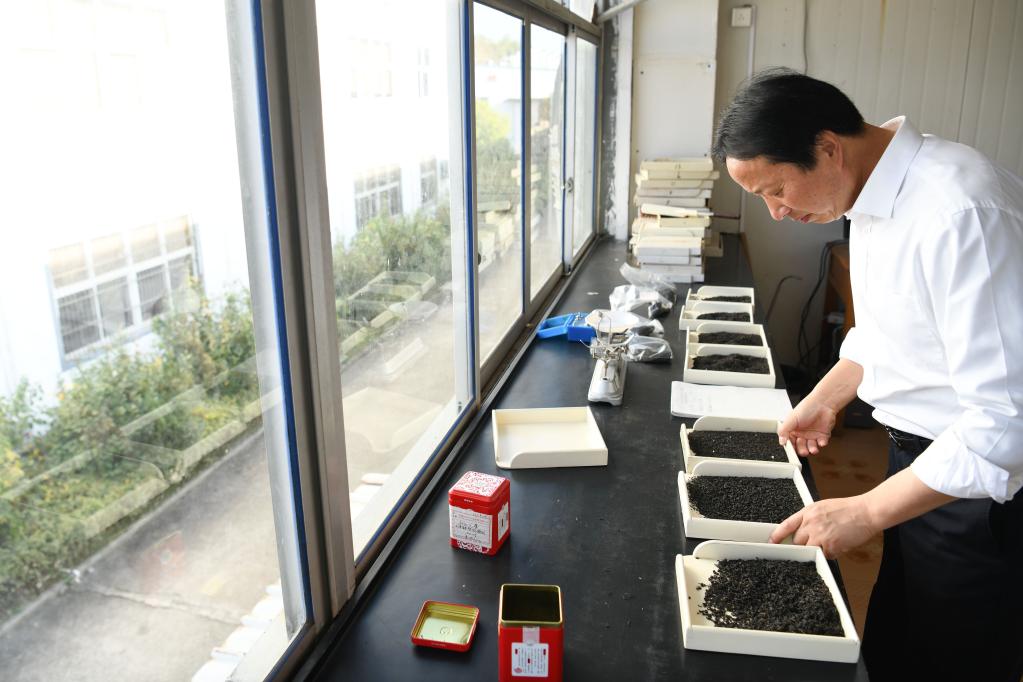
Wang Chang does the blending processing of Keemun black tea at his tea company in Qimen County, east China's Anhui Province, Nov. 26, 2022. Keemun black tea, one of the most famous Chinese tea with intensive aroma, has a history of more than 100 years. The tea, also called "Qihong" in Chinese, plays an important role in cultural exchanges between the west and the east. In 2008, the making of Keemun black tea was listed as China's national-level intangible cultural heritage, and nowadays the tea has become a symbol for Anhui Province or even China.
The primary processing of Keemun black tea includes four steps, namely natural withering, rolling, fermenting and drying, lasting from before the Qingming festival (April) to June. After that, the refining of the tea is much more complicated, which mainly includes procedures such as screening, winnowing, compressing, re-drying, blending, piling and packing. Of all the refining steps, blending is the key, which decides the shape, scent, and color of the final tea product.
Wang Chang, born in 1966 in the hometown of Keemun black tea Qimen, has devoted his whole life to the making of the "oriental leaf". As the inheritor of the intangible cultural heritage, he started to know the tea as a child when his father worked in a tea factory and his mother as a tea farmer. He used to sit in a wicker basket hung on the shoulder pole carried by his mother while the other side was the tea basket at that time. Gradually, the Keemun black tea became an indispensable part of him.
In 2008, Wang set up a Keemun black tea company in Qimen County, which not only produces and sells the tea, but also conducts researches on the tea and organizes tea culture activities. Since its foundation, the company has cooperated with China Agricultural University and Anhui Academy of Agricultural Sciences on the making of Keemun black tea and on the building of a smart and clean production line. "Tianzhihong", Keemun black tea product of the company, won the gold award during the World Expo in Milan in 2015 and the grand gold medal during the World Black Tea Quality Evaluation Competition in China in 2019.
By far, Wang Chang has accepted over 40 apprentices on the making of Keemun black tea, among whom arise tea masters and new tea talents. He also organizes campus activities on the intangible cultural heritage and builds practicing bases for college students. In recent years, he has made efforts in the brand promotion, standard setting and quality improvement of Keemun black tea, aiming to make the green leaf a "gold leaf" to enrich the local people and promote the traditional Chinese tea culture. (Xinhua/Zhang Duan)
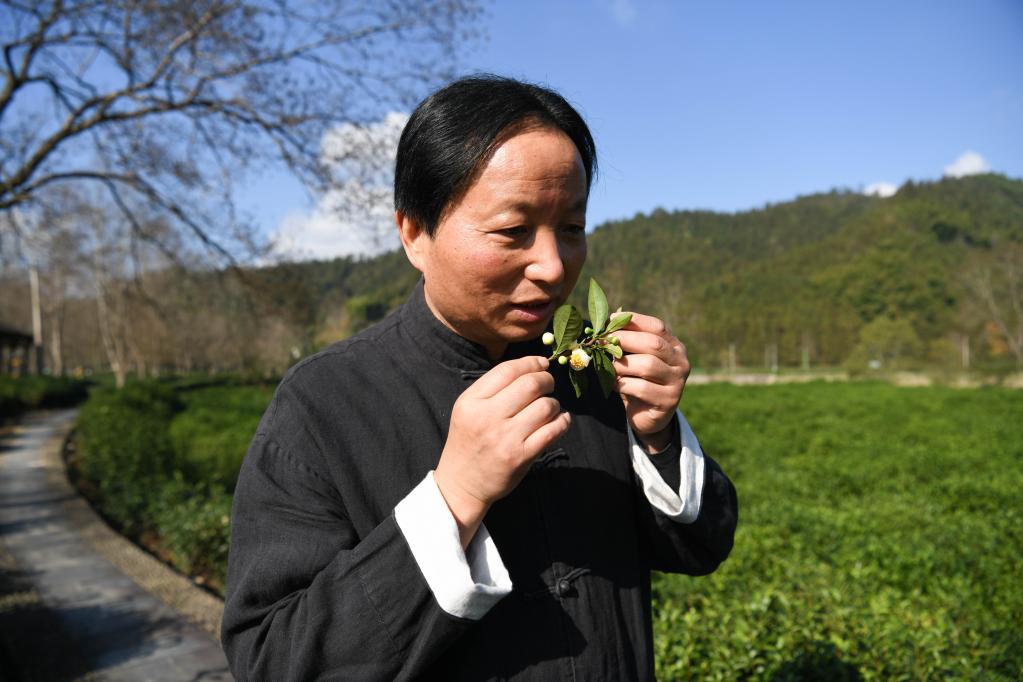
Wang Chang smells the scent of tea flowers at a tea garden in Qimen County, east China's Anhui Province, Nov. 26, 2022. Keemun black tea, one of the most famous Chinese tea with intensive aroma, has a history of more than 100 years. The tea, also called "Qihong" in Chinese, plays an important role in cultural exchanges between the west and the east. In 2008, the making of Keemun black tea was listed as China's national-level intangible cultural heritage, and nowadays the tea has become a symbol for Anhui Province or even China.
The primary processing of Keemun black tea includes four steps, namely natural withering, rolling, fermenting and drying, lasting from before the Qingming festival (April) to June. After that, the refining of the tea is much more complicated, which mainly includes procedures such as screening, winnowing, compressing, re-drying, blending, piling and packing. Of all the refining steps, blending is the key, which decides the shape, scent, and color of the final tea product.
Wang Chang, born in 1966 in the hometown of Keemun black tea Qimen, has devoted his whole life to the making of the "oriental leaf". As the inheritor of the intangible cultural heritage, he started to know the tea as a child when his father worked in a tea factory and his mother as a tea farmer. He used to sit in a wicker basket hung on the shoulder pole carried by his mother while the other side was the tea basket at that time. Gradually, the Keemun black tea became an indispensable part of him.
In 2008, Wang set up a Keemun black tea company in Qimen County, which not only produces and sells the tea, but also conducts researches on the tea and organizes tea culture activities. Since its foundation, the company has cooperated with China Agricultural University and Anhui Academy of Agricultural Sciences on the making of Keemun black tea and on the building of a smart and clean production line. "Tianzhihong", Keemun black tea product of the company, won the gold award during the World Expo in Milan in 2015 and the grand gold medal during the World Black Tea Quality Evaluation Competition in China in 2019.
By far, Wang Chang has accepted over 40 apprentices on the making of Keemun black tea, among whom arise tea masters and new tea talents. He also organizes campus activities on the intangible cultural heritage and builds practicing bases for college students. In recent years, he has made efforts in the brand promotion, standard setting and quality improvement of Keemun black tea, aiming to make the green leaf a "gold leaf" to enrich the local people and promote the traditional Chinese tea culture. (Xinhua/Zhang Duan)
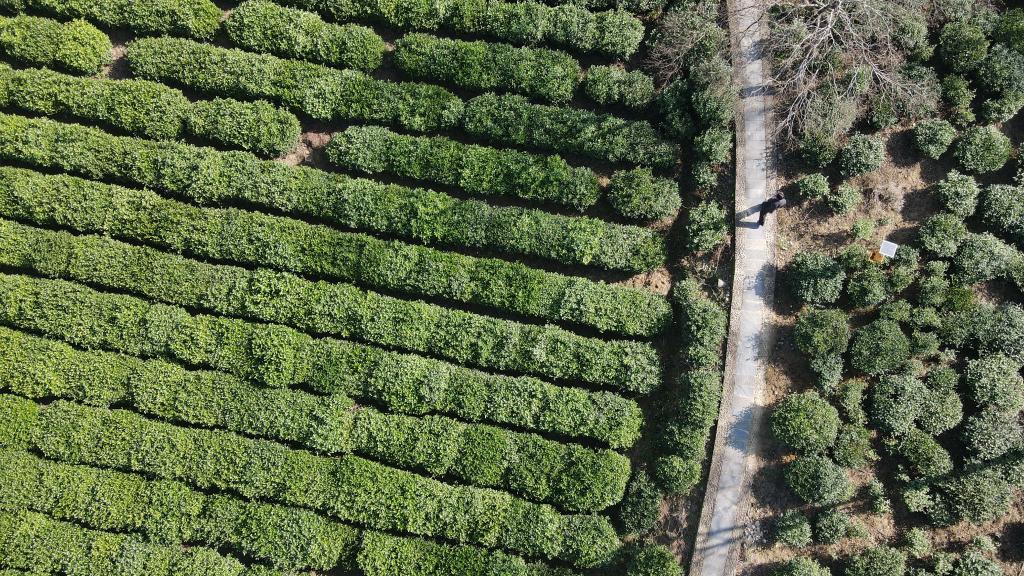
This aerial photo taken on Nov. 26, 2022 shows Wang Chang walking at a tea garden in Qimen County, east China's Anhui Province. Keemun black tea, one of the most famous Chinese tea with intensive aroma, has a history of more than 100 years. The tea, also called "Qihong" in Chinese, plays an important role in cultural exchanges between the west and the east. In 2008, the making of Keemun black tea was listed as China's national-level intangible cultural heritage, and nowadays the tea has become a symbol for Anhui Province or even China.
The primary processing of Keemun black tea includes four steps, namely natural withering, rolling, fermenting and drying, lasting from before the Qingming festival (April) to June. After that, the refining of the tea is much more complicated, which mainly includes procedures such as screening, winnowing, compressing, re-drying, blending, piling and packing. Of all the refining steps, blending is the key, which decides the shape, scent, and color of the final tea product.
Wang Chang, born in 1966 in the hometown of Keemun black tea Qimen, has devoted his whole life to the making of the "oriental leaf". As the inheritor of the intangible cultural heritage, he started to know the tea as a child when his father worked in a tea factory and his mother as a tea farmer. He used to sit in a wicker basket hung on the shoulder pole carried by his mother while the other side was the tea basket at that time. Gradually, the Keemun black tea became an indispensable part of him.
In 2008, Wang set up a Keemun black tea company in Qimen County, which not only produces and sells the tea, but also conducts researches on the tea and organizes tea culture activities. Since its foundation, the company has cooperated with China Agricultural University and Anhui Academy of Agricultural Sciences on the making of Keemun black tea and on the building of a smart and clean production line. "Tianzhihong", Keemun black tea product of the company, won the gold award during the World Expo in Milan in 2015 and the grand gold medal during the World Black Tea Quality Evaluation Competition in China in 2019.
By far, Wang Chang has accepted over 40 apprentices on the making of Keemun black tea, among whom arise tea masters and new tea talents. He also organizes campus activities on the intangible cultural heritage and builds practicing bases for college students. In recent years, he has made efforts in the brand promotion, standard setting and quality improvement of Keemun black tea, aiming to make the green leaf a "gold leaf" to enrich the local people and promote the traditional Chinese tea culture. (Xinhua/Zhang Duan)
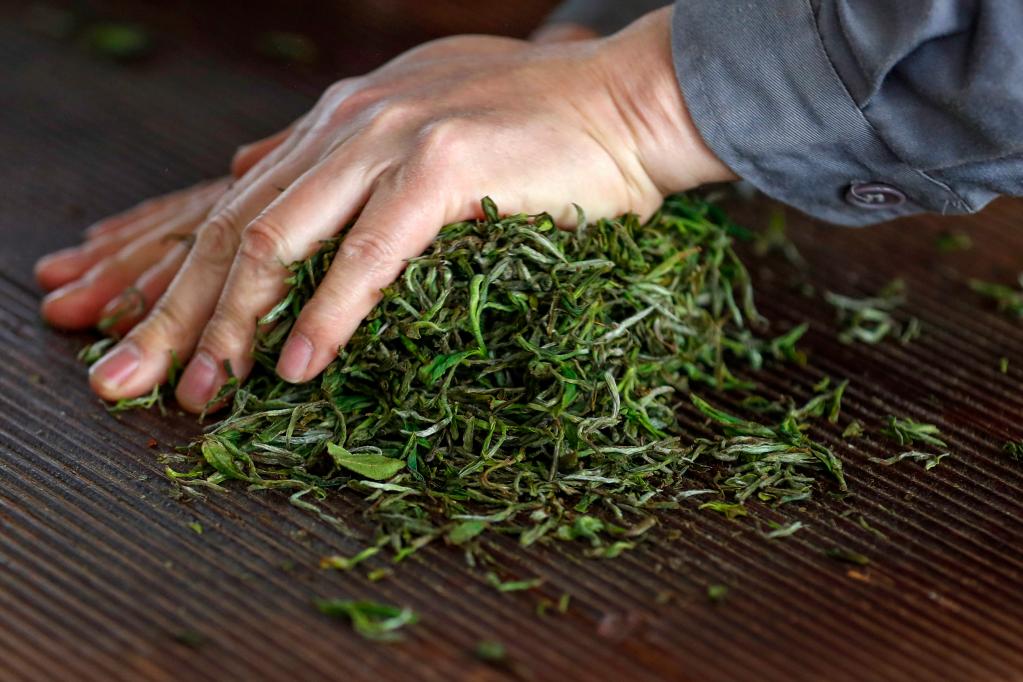
A worker rolls tea leaves after withering at Wang Chang's tea company in Qimen County, east China's Anhui Province, March 28, 2022. Keemun black tea, one of the most famous Chinese tea with intensive aroma, has a history of more than 100 years. The tea, also called "Qihong" in Chinese, plays an important role in cultural exchanges between the west and the east. In 2008, the making of Keemun black tea was listed as China's national-level intangible cultural heritage, and nowadays the tea has become a symbol for Anhui Province or even China.
The primary processing of Keemun black tea includes four steps, namely natural withering, rolling, fermenting and drying, lasting from before the Qingming festival (April) to June. After that, the refining of the tea is much more complicated, which mainly includes procedures such as screening, winnowing, compressing, re-drying, blending, piling and packing. Of all the refining steps, blending is the key, which decides the shape, scent, and color of the final tea product.
Wang Chang, born in 1966 in the hometown of Keemun black tea Qimen, has devoted his whole life to the making of the "oriental leaf". As the inheritor of the intangible cultural heritage, he started to know the tea as a child when his father worked in a tea factory and his mother as a tea farmer. He used to sit in a wicker basket hung on the shoulder pole carried by his mother while the other side was the tea basket at that time. Gradually, the Keemun black tea became an indispensable part of him.
In 2008, Wang set up a Keemun black tea company in Qimen County, which not only produces and sells the tea, but also conducts researches on the tea and organizes tea culture activities. Since its foundation, the company has cooperated with China Agricultural University and Anhui Academy of Agricultural Sciences on the making of Keemun black tea and on the building of a smart and clean production line. "Tianzhihong", Keemun black tea product of the company, won the gold award during the World Expo in Milan in 2015 and the grand gold medal during the World Black Tea Quality Evaluation Competition in China in 2019.
By far, Wang Chang has accepted over 40 apprentices on the making of Keemun black tea, among whom arise tea masters and new tea talents. He also organizes campus activities on the intangible cultural heritage and builds practicing bases for college students. In recent years, he has made efforts in the brand promotion, standard setting and quality improvement of Keemun black tea, aiming to make the green leaf a "gold leaf" to enrich the local people and promote the traditional Chinese tea culture. (Photo by Shi Yalei/Xinhua)
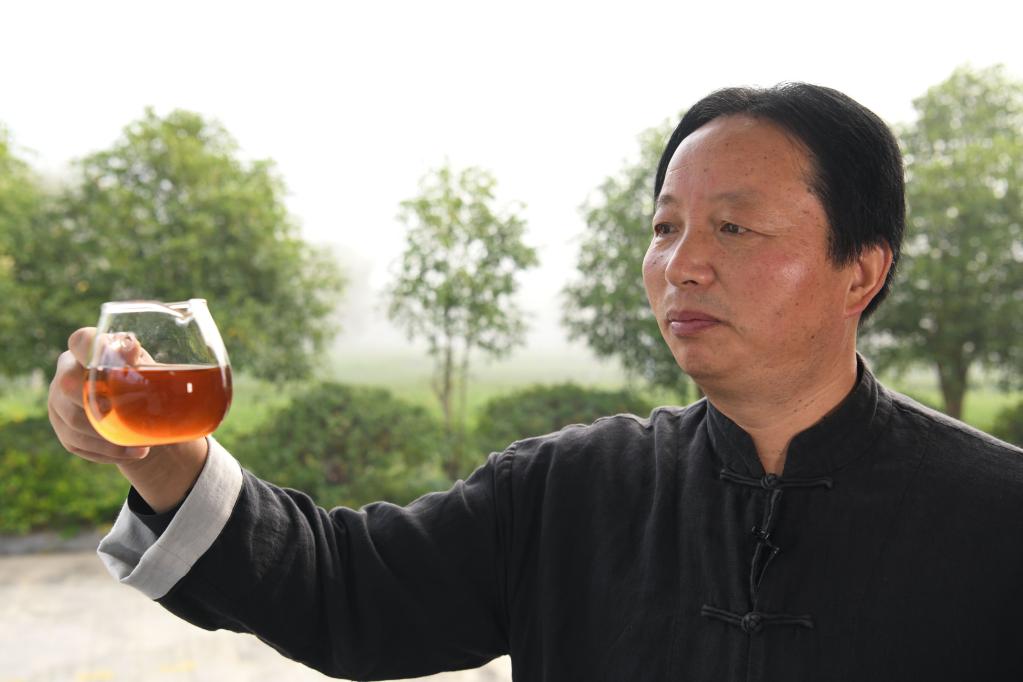
Wang Chang tastes a cup of Keemun black tea at a tea garden in Qimen County, east China's Anhui Province, Nov. 26, 2022. Keemun black tea, one of the most famous Chinese tea with intensive aroma, has a history of more than 100 years. The tea, also called "Qihong" in Chinese, plays an important role in cultural exchanges between the west and the east. In 2008, the making of Keemun black tea was listed as China's national-level intangible cultural heritage, and nowadays the tea has become a symbol for Anhui Province or even China.
The primary processing of Keemun black tea includes four steps, namely natural withering, rolling, fermenting and drying, lasting from before the Qingming festival (April) to June. After that, the refining of the tea is much more complicated, which mainly includes procedures such as screening, winnowing, compressing, re-drying, blending, piling and packing. Of all the refining steps, blending is the key, which decides the shape, scent, and color of the final tea product.
Wang Chang, born in 1966 in the hometown of Keemun black tea Qimen, has devoted his whole life to the making of the "oriental leaf". As the inheritor of the intangible cultural heritage, he started to know the tea as a child when his father worked in a tea factory and his mother as a tea farmer. He used to sit in a wicker basket hung on the shoulder pole carried by his mother while the other side was the tea basket at that time. Gradually, the Keemun black tea became an indispensable part of him.
In 2008, Wang set up a Keemun black tea company in Qimen County, which not only produces and sells the tea, but also conducts researches on the tea and organizes tea culture activities. Since its foundation, the company has cooperated with China Agricultural University and Anhui Academy of Agricultural Sciences on the making of Keemun black tea and on the building of a smart and clean production line. "Tianzhihong", Keemun black tea product of the company, won the gold award during the World Expo in Milan in 2015 and the grand gold medal during the World Black Tea Quality Evaluation Competition in China in 2019.
By far, Wang Chang has accepted over 40 apprentices on the making of Keemun black tea, among whom arise tea masters and new tea talents. He also organizes campus activities on the intangible cultural heritage and builds practicing bases for college students. In recent years, he has made efforts in the brand promotion, standard setting and quality improvement of Keemun black tea, aiming to make the green leaf a "gold leaf" to enrich the local people and promote the traditional Chinese tea culture. (Xinhua/Zhang Duan)
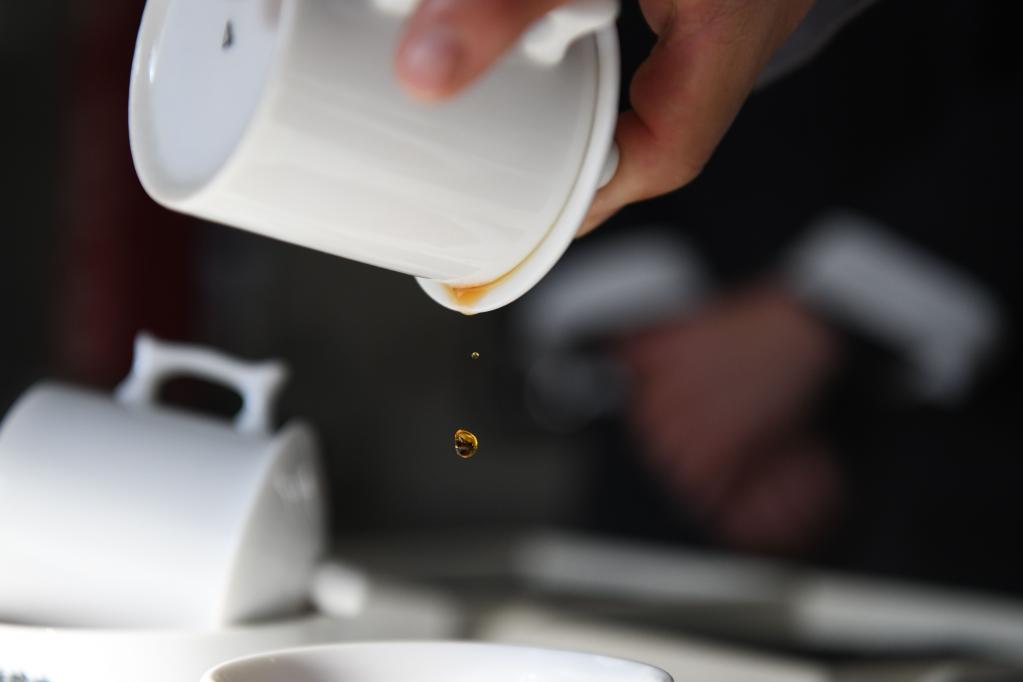
Fan Wenhan, apprentice of Wang Chang, evaluates a Keemun black tea product at a tea garden in Qimen County, east China's Anhui Province, Nov. 26, 2022. Keemun black tea, one of the most famous Chinese tea with intensive aroma, has a history of more than 100 years. The tea, also called "Qihong" in Chinese, plays an important role in cultural exchanges between the west and the east. In 2008, the making of Keemun black tea was listed as China's national-level intangible cultural heritage, and nowadays the tea has become a symbol for Anhui Province or even China.
The primary processing of Keemun black tea includes four steps, namely natural withering, rolling, fermenting and drying, lasting from before the Qingming festival (April) to June. After that, the refining of the tea is much more complicated, which mainly includes procedures such as screening, winnowing, compressing, re-drying, blending, piling and packing. Of all the refining steps, blending is the key, which decides the shape, scent, and color of the final tea product.
Wang Chang, born in 1966 in the hometown of Keemun black tea Qimen, has devoted his whole life to the making of the "oriental leaf". As the inheritor of the intangible cultural heritage, he started to know the tea as a child when his father worked in a tea factory and his mother as a tea farmer. He used to sit in a wicker basket hung on the shoulder pole carried by his mother while the other side was the tea basket at that time. Gradually, the Keemun black tea became an indispensable part of him.
In 2008, Wang set up a Keemun black tea company in Qimen County, which not only produces and sells the tea, but also conducts researches on the tea and organizes tea culture activities. Since its foundation, the company has cooperated with China Agricultural University and Anhui Academy of Agricultural Sciences on the making of Keemun black tea and on the building of a smart and clean production line. "Tianzhihong", Keemun black tea product of the company, won the gold award during the World Expo in Milan in 2015 and the grand gold medal during the World Black Tea Quality Evaluation Competition in China in 2019.
By far, Wang Chang has accepted over 40 apprentices on the making of Keemun black tea, among whom arise tea masters and new tea talents. He also organizes campus activities on the intangible cultural heritage and builds practicing bases for college students. In recent years, he has made efforts in the brand promotion, standard setting and quality improvement of Keemun black tea, aiming to make the green leaf a "gold leaf" to enrich the local people and promote the traditional Chinese tea culture. (Xinhua/Zhang Duan)
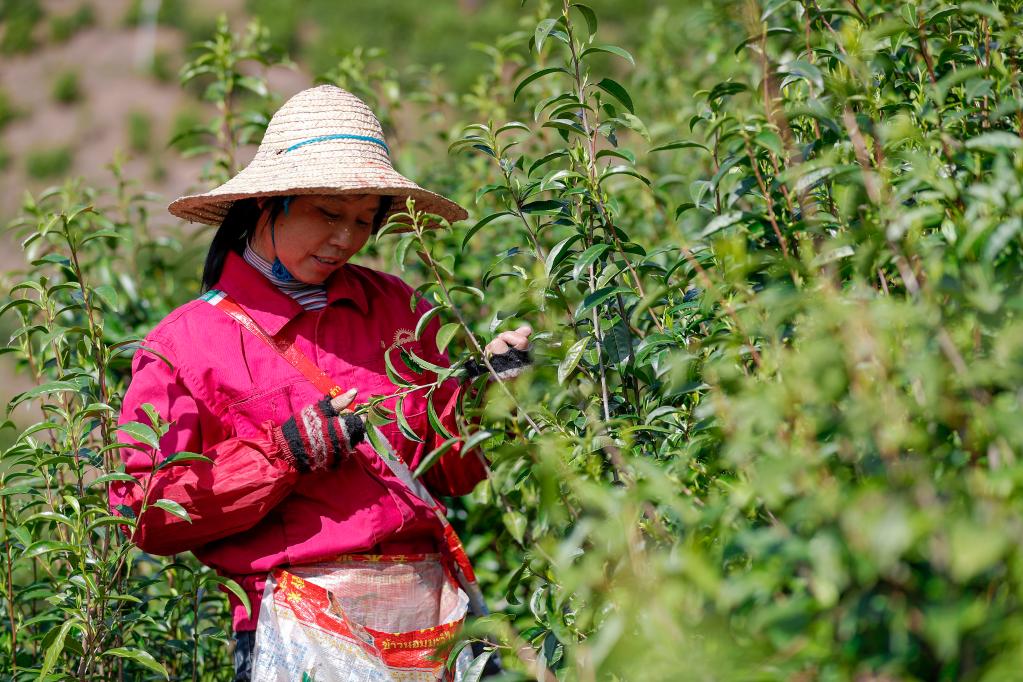
A farmer picks tea leaves at a tea garden in Qimen County, east China's Anhui Province, March 28, 2022. Keemun black tea, one of the most famous Chinese tea with intensive aroma, has a history of more than 100 years. The tea, also called "Qihong" in Chinese, plays an important role in cultural exchanges between the west and the east. In 2008, the making of Keemun black tea was listed as China's national-level intangible cultural heritage, and nowadays the tea has become a symbol for Anhui Province or even China.
The primary processing of Keemun black tea includes four steps, namely natural withering, rolling, fermenting and drying, lasting from before the Qingming festival (April) to June. After that, the refining of the tea is much more complicated, which mainly includes procedures such as screening, winnowing, compressing, re-drying, blending, piling and packing. Of all the refining steps, blending is the key, which decides the shape, scent, and color of the final tea product.
Wang Chang, born in 1966 in the hometown of Keemun black tea Qimen, has devoted his whole life to the making of the "oriental leaf". As the inheritor of the intangible cultural heritage, he started to know the tea as a child when his father worked in a tea factory and his mother as a tea farmer. He used to sit in a wicker basket hung on the shoulder pole carried by his mother while the other side was the tea basket at that time. Gradually, the Keemun black tea became an indispensable part of him.
In 2008, Wang set up a Keemun black tea company in Qimen County, which not only produces and sells the tea, but also conducts researches on the tea and organizes tea culture activities. Since its foundation, the company has cooperated with China Agricultural University and Anhui Academy of Agricultural Sciences on the making of Keemun black tea and on the building of a smart and clean production line. "Tianzhihong", Keemun black tea product of the company, won the gold award during the World Expo in Milan in 2015 and the grand gold medal during the World Black Tea Quality Evaluation Competition in China in 2019.
By far, Wang Chang has accepted over 40 apprentices on the making of Keemun black tea, among whom arise tea masters and new tea talents. He also organizes campus activities on the intangible cultural heritage and builds practicing bases for college students. In recent years, he has made efforts in the brand promotion, standard setting and quality improvement of Keemun black tea, aiming to make the green leaf a "gold leaf" to enrich the local people and promote the traditional Chinese tea culture. (Photo by Shi Yalei/Xinhua)
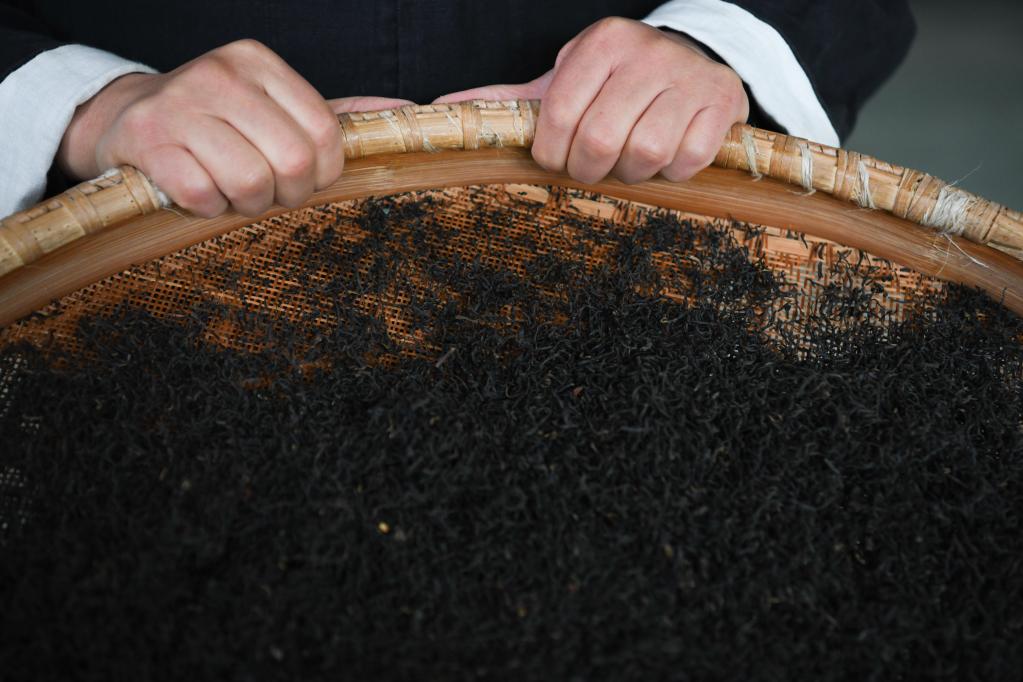
Wang Chang does the sieving processing of keemun black tea at a tea garden in Qimen County, east China's Anhui Province, Nov. 26, 2022. Keemun black tea, one of the most famous Chinese tea with intensive aroma, has a history of more than 100 years. The tea, also called "Qihong" in Chinese, plays an important role in cultural exchanges between the west and the east. In 2008, the making of Keemun black tea was listed as China's national-level intangible cultural heritage, and nowadays the tea has become a symbol for Anhui Province or even China.
The primary processing of Keemun black tea includes four steps, namely natural withering, rolling, fermenting and drying, lasting from before the Qingming festival (April) to June. After that, the refining of the tea is much more complicated, which mainly includes procedures such as screening, winnowing, compressing, re-drying, blending, piling and packing. Of all the refining steps, blending is the key, which decides the shape, scent, and color of the final tea product.
Wang Chang, born in 1966 in the hometown of Keemun black tea Qimen, has devoted his whole life to the making of the "oriental leaf". As the inheritor of the intangible cultural heritage, he started to know the tea as a child when his father worked in a tea factory and his mother as a tea farmer. He used to sit in a wicker basket hung on the shoulder pole carried by his mother while the other side was the tea basket at that time. Gradually, the Keemun black tea became an indispensable part of him.
In 2008, Wang set up a Keemun black tea company in Qimen County, which not only produces and sells the tea, but also conducts researches on the tea and organizes tea culture activities. Since its foundation, the company has cooperated with China Agricultural University and Anhui Academy of Agricultural Sciences on the making of Keemun black tea and on the building of a smart and clean production line. "Tianzhihong", Keemun black tea product of the company, won the gold award during the World Expo in Milan in 2015 and the grand gold medal during the World Black Tea Quality Evaluation Competition in China in 2019.
By far, Wang Chang has accepted over 40 apprentices on the making of Keemun black tea, among whom arise tea masters and new tea talents. He also organizes campus activities on the intangible cultural heritage and builds practicing bases for college students. In recent years, he has made efforts in the brand promotion, standard setting and quality improvement of Keemun black tea, aiming to make the green leaf a "gold leaf" to enrich the local people and promote the traditional Chinese tea culture. (Xinhua/Zhang Duan)

Wang Chang pours a cup of keemun black tea at a tea garden in Qimen County, east China's Anhui Province, Nov. 26, 2022. Keemun black tea, one of the most famous Chinese tea with intensive aroma, has a history of more than 100 years. The tea, also called "Qihong" in Chinese, plays an important role in cultural exchanges between the west and the east. In 2008, the making of Keemun black tea was listed as China's national-level intangible cultural heritage, and nowadays the tea has become a symbol for Anhui Province or even China.
The primary processing of Keemun black tea includes four steps, namely natural withering, rolling, fermenting and drying, lasting from before the Qingming festival (April) to June. After that, the refining of the tea is much more complicated, which mainly includes procedures such as screening, winnowing, compressing, re-drying, blending, piling and packing. Of all the refining steps, blending is the key, which decides the shape, scent, and color of the final tea product.
Wang Chang, born in 1966 in the hometown of Keemun black tea Qimen, has devoted his whole life to the making of the "oriental leaf". As the inheritor of the intangible cultural heritage, he started to know the tea as a child when his father worked in a tea factory and his mother as a tea farmer. He used to sit in a wicker basket hung on the shoulder pole carried by his mother while the other side was the tea basket at that time. Gradually, the Keemun black tea became an indispensable part of him.
In 2008, Wang set up a Keemun black tea company in Qimen County, which not only produces and sells the tea, but also conducts researches on the tea and organizes tea culture activities. Since its foundation, the company has cooperated with China Agricultural University and Anhui Academy of Agricultural Sciences on the making of Keemun black tea and on the building of a smart and clean production line. "Tianzhihong", Keemun black tea product of the company, won the gold award during the World Expo in Milan in 2015 and the grand gold medal during the World Black Tea Quality Evaluation Competition in China in 2019.
By far, Wang Chang has accepted over 40 apprentices on the making of Keemun black tea, among whom arise tea masters and new tea talents. He also organizes campus activities on the intangible cultural heritage and builds practicing bases for college students. In recent years, he has made efforts in the brand promotion, standard setting and quality improvement of Keemun black tea, aiming to make the green leaf a "gold leaf" to enrich the local people and promote the traditional Chinese tea culture. (Xinhua/Zhang Duan)
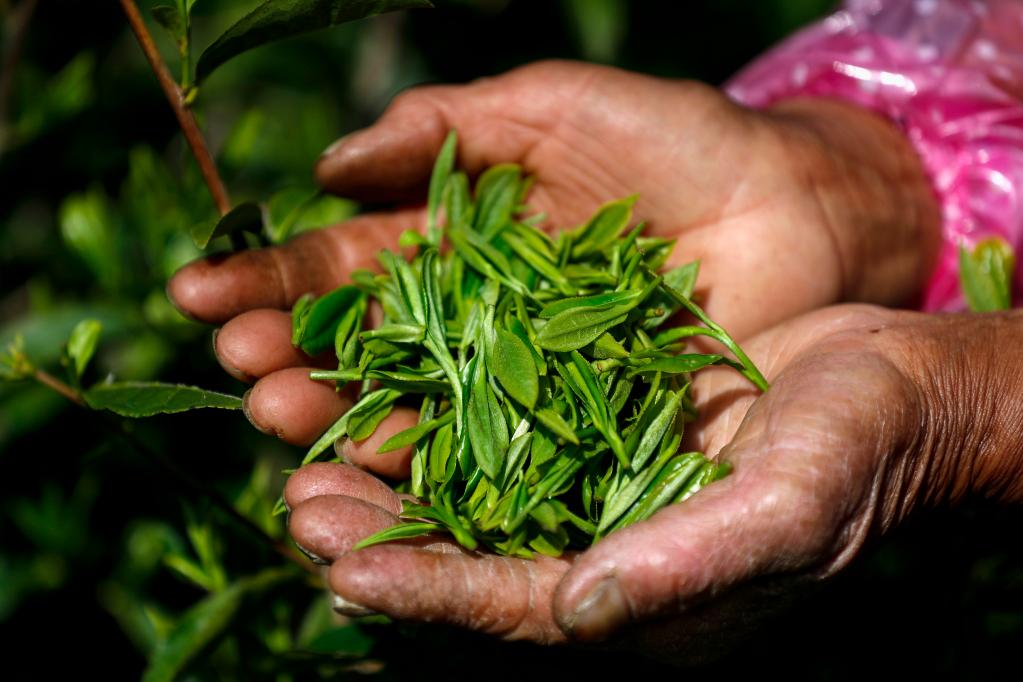
A farmer shows newly-picked tea leaves at a tea garden in Qimen County, east China's Anhui Province, March 28, 2022. Keemun black tea, one of the most famous Chinese tea with intensive aroma, has a history of more than 100 years. The tea, also called "Qihong" in Chinese, plays an important role in cultural exchanges between the west and the east. In 2008, the making of Keemun black tea was listed as China's national-level intangible cultural heritage, and nowadays the tea has become a symbol for Anhui Province or even China.
The primary processing of Keemun black tea includes four steps, namely natural withering, rolling, fermenting and drying, lasting from before the Qingming festival (April) to June. After that, the refining of the tea is much more complicated, which mainly includes procedures such as screening, winnowing, compressing, re-drying, blending, piling and packing. Of all the refining steps, blending is the key, which decides the shape, scent, and color of the final tea product.
Wang Chang, born in 1966 in the hometown of Keemun black tea Qimen, has devoted his whole life to the making of the "oriental leaf". As the inheritor of the intangible cultural heritage, he started to know the tea as a child when his father worked in a tea factory and his mother as a tea farmer. He used to sit in a wicker basket hung on the shoulder pole carried by his mother while the other side was the tea basket at that time. Gradually, the Keemun black tea became an indispensable part of him.
In 2008, Wang set up a Keemun black tea company in Qimen County, which not only produces and sells the tea, but also conducts researches on the tea and organizes tea culture activities. Since its foundation, the company has cooperated with China Agricultural University and Anhui Academy of Agricultural Sciences on the making of Keemun black tea and on the building of a smart and clean production line. "Tianzhihong", Keemun black tea product of the company, won the gold award during the World Expo in Milan in 2015 and the grand gold medal during the World Black Tea Quality Evaluation Competition in China in 2019.
By far, Wang Chang has accepted over 40 apprentices on the making of Keemun black tea, among whom arise tea masters and new tea talents. He also organizes campus activities on the intangible cultural heritage and builds practicing bases for college students. In recent years, he has made efforts in the brand promotion, standard setting and quality improvement of Keemun black tea, aiming to make the green leaf a "gold leaf" to enrich the local people and promote the traditional Chinese tea culture. (Photo by Shi Yalei/Xinhua)
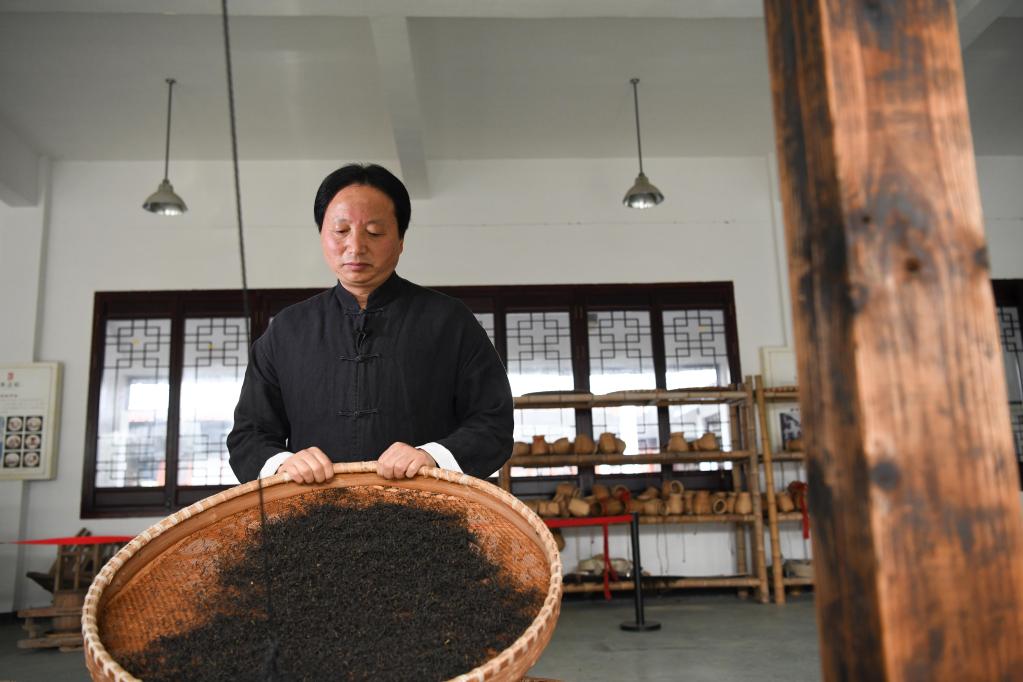
Wang Chang does the sieving processing of keemun black tea at a tea garden in Qimen County, east China's Anhui Province, Nov. 26, 2022. Keemun black tea, one of the most famous Chinese tea with intensive aroma, has a history of more than 100 years. The tea, also called "Qihong" in Chinese, plays an important role in cultural exchanges between the west and the east. In 2008, the making of Keemun black tea was listed as China's national-level intangible cultural heritage, and nowadays the tea has become a symbol for Anhui Province or even China.
The primary processing of Keemun black tea includes four steps, namely natural withering, rolling, fermenting and drying, lasting from before the Qingming festival (April) to June. After that, the refining of the tea is much more complicated, which mainly includes procedures such as screening, winnowing, compressing, re-drying, blending, piling and packing. Of all the refining steps, blending is the key, which decides the shape, scent, and color of the final tea product.
Wang Chang, born in 1966 in the hometown of Keemun black tea Qimen, has devoted his whole life to the making of the "oriental leaf". As the inheritor of the intangible cultural heritage, he started to know the tea as a child when his father worked in a tea factory and his mother as a tea farmer. He used to sit in a wicker basket hung on the shoulder pole carried by his mother while the other side was the tea basket at that time. Gradually, the Keemun black tea became an indispensable part of him.
In 2008, Wang set up a Keemun black tea company in Qimen County, which not only produces and sells the tea, but also conducts researches on the tea and organizes tea culture activities. Since its foundation, the company has cooperated with China Agricultural University and Anhui Academy of Agricultural Sciences on the making of Keemun black tea and on the building of a smart and clean production line. "Tianzhihong", Keemun black tea product of the company, won the gold award during the World Expo in Milan in 2015 and the grand gold medal during the World Black Tea Quality Evaluation Competition in China in 2019.
By far, Wang Chang has accepted over 40 apprentices on the making of Keemun black tea, among whom arise tea masters and new tea talents. He also organizes campus activities on the intangible cultural heritage and builds practicing bases for college students. In recent years, he has made efforts in the brand promotion, standard setting and quality improvement of Keemun black tea, aiming to make the green leaf a "gold leaf" to enrich the local people and promote the traditional Chinese tea culture. (Xinhua/Zhang Duan)
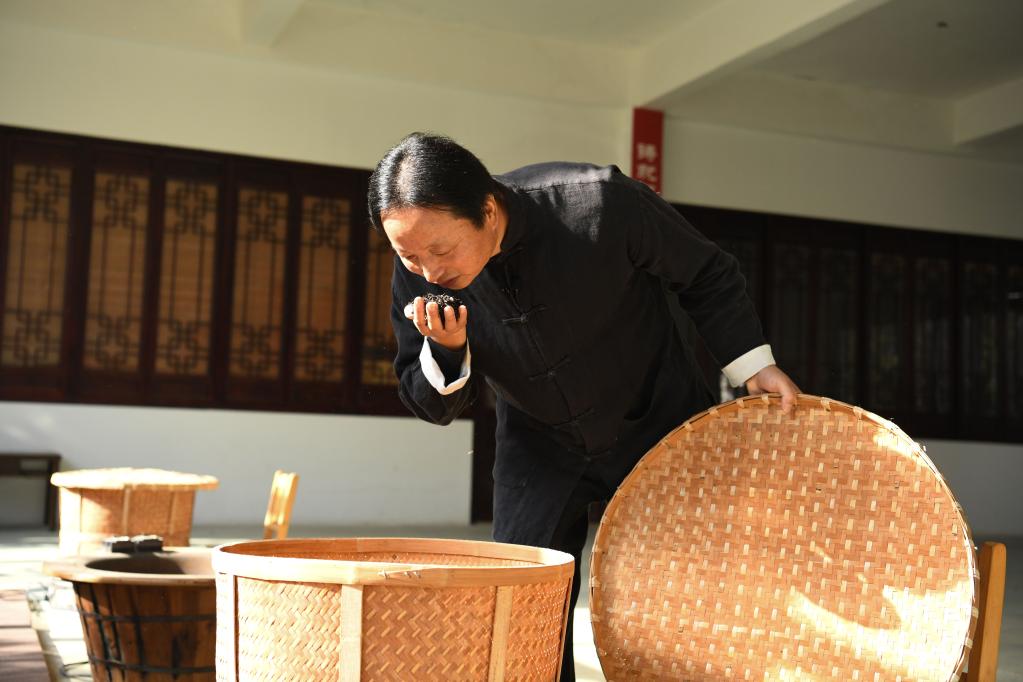
Wang Chang smells the scent of Keemun black tea at a tea garden in Qimen County, east China's Anhui Province, Nov. 26, 2022. Keemun black tea, one of the most famous Chinese tea with intensive aroma, has a history of more than 100 years. The tea, also called "Qihong" in Chinese, plays an important role in cultural exchanges between the west and the east. In 2008, the making of Keemun black tea was listed as China's national-level intangible cultural heritage, and nowadays the tea has become a symbol for Anhui Province or even China.
The primary processing of Keemun black tea includes four steps, namely natural withering, rolling, fermenting and drying, lasting from before the Qingming festival (April) to June. After that, the refining of the tea is much more complicated, which mainly includes procedures such as screening, winnowing, compressing, re-drying, blending, piling and packing. Of all the refining steps, blending is the key, which decides the shape, scent, and color of the final tea product.
Wang Chang, born in 1966 in the hometown of Keemun black tea Qimen, has devoted his whole life to the making of the "oriental leaf". As the inheritor of the intangible cultural heritage, he started to know the tea as a child when his father worked in a tea factory and his mother as a tea farmer. He used to sit in a wicker basket hung on the shoulder pole carried by his mother while the other side was the tea basket at that time. Gradually, the Keemun black tea became an indispensable part of him.
In 2008, Wang set up a Keemun black tea company in Qimen County, which not only produces and sells the tea, but also conducts researches on the tea and organizes tea culture activities. Since its foundation, the company has cooperated with China Agricultural University and Anhui Academy of Agricultural Sciences on the making of Keemun black tea and on the building of a smart and clean production line. "Tianzhihong", Keemun black tea product of the company, won the gold award during the World Expo in Milan in 2015 and the grand gold medal during the World Black Tea Quality Evaluation Competition in China in 2019.
By far, Wang Chang has accepted over 40 apprentices on the making of Keemun black tea, among whom arise tea masters and new tea talents. He also organizes campus activities on the intangible cultural heritage and builds practicing bases for college students. In recent years, he has made efforts in the brand promotion, standard setting and quality improvement of Keemun black tea, aiming to make the green leaf a "gold leaf" to enrich the local people and promote the traditional Chinese tea culture. (Xinhua/Zhang Duan)
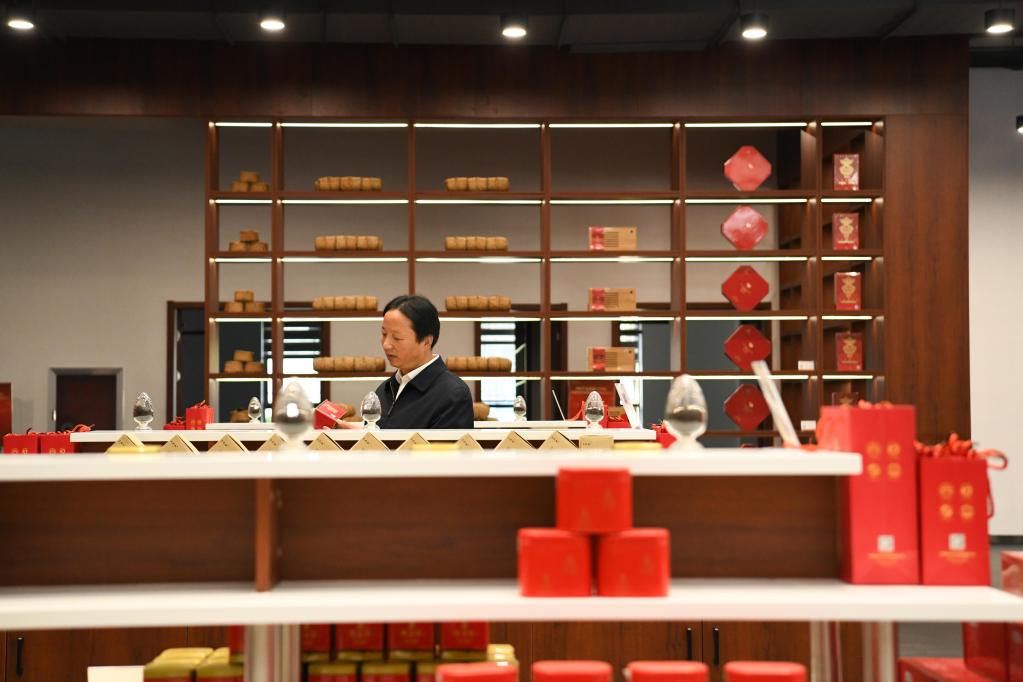
Wang Chang checks Keemun black tea products at his tea company in Qimen County, east China's Anhui Province, Nov. 26, 2022. Keemun black tea, one of the most famous Chinese tea with intensive aroma, has a history of more than 100 years. The tea, also called "Qihong" in Chinese, plays an important role in cultural exchanges between the west and the east. In 2008, the making of Keemun black tea was listed as China's national-level intangible cultural heritage, and nowadays the tea has become a symbol for Anhui Province or even China.
The primary processing of Keemun black tea includes four steps, namely natural withering, rolling, fermenting and drying, lasting from before the Qingming festival (April) to June. After that, the refining of the tea is much more complicated, which mainly includes procedures such as screening, winnowing, compressing, re-drying, blending, piling and packing. Of all the refining steps, blending is the key, which decides the shape, scent, and color of the final tea product.
Wang Chang, born in 1966 in the hometown of Keemun black tea Qimen, has devoted his whole life to the making of the "oriental leaf". As the inheritor of the intangible cultural heritage, he started to know the tea as a child when his father worked in a tea factory and his mother as a tea farmer. He used to sit in a wicker basket hung on the shoulder pole carried by his mother while the other side was the tea basket at that time. Gradually, the Keemun black tea became an indispensable part of him.
In 2008, Wang set up a Keemun black tea company in Qimen County, which not only produces and sells the tea, but also conducts researches on the tea and organizes tea culture activities. Since its foundation, the company has cooperated with China Agricultural University and Anhui Academy of Agricultural Sciences on the making of Keemun black tea and on the building of a smart and clean production line. "Tianzhihong", Keemun black tea product of the company, won the gold award during the World Expo in Milan in 2015 and the grand gold medal during the World Black Tea Quality Evaluation Competition in China in 2019.
By far, Wang Chang has accepted over 40 apprentices on the making of Keemun black tea, among whom arise tea masters and new tea talents. He also organizes campus activities on the intangible cultural heritage and builds practicing bases for college students. In recent years, he has made efforts in the brand promotion, standard setting and quality improvement of Keemun black tea, aiming to make the green leaf a "gold leaf" to enrich the local people and promote the traditional Chinese tea culture. (Xinhua/Zhang Duan)
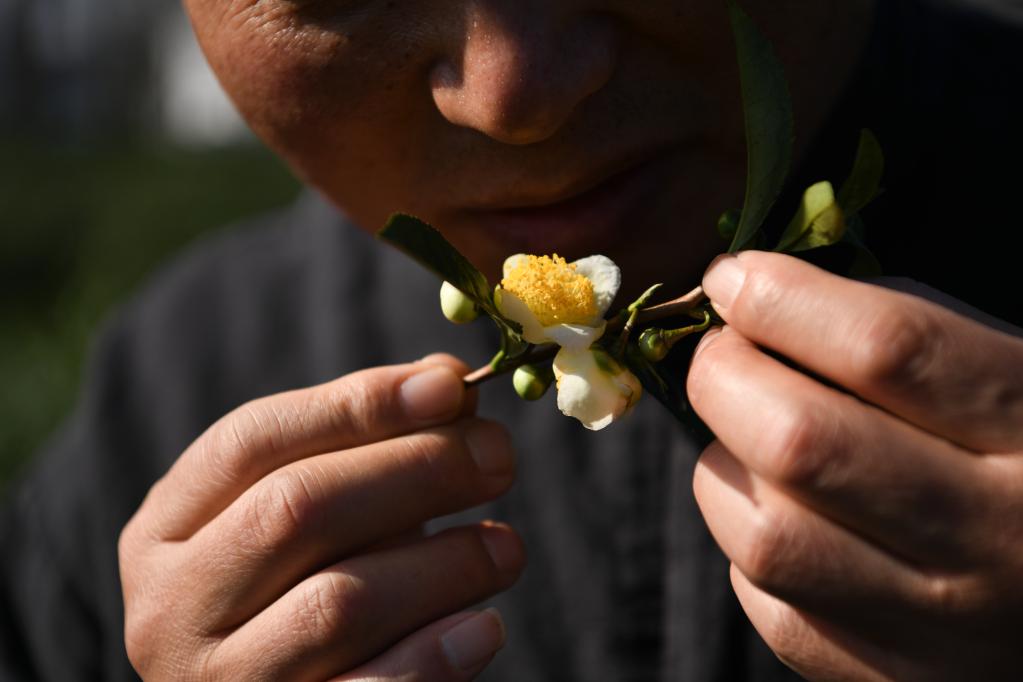
Wang Chang smells the scent of tea flowers at a tea garden in Qimen County, east China's Anhui Province, Nov. 26, 2022. Keemun black tea, one of the most famous Chinese tea with intensive aroma, has a history of more than 100 years. The tea, also called "Qihong" in Chinese, plays an important role in cultural exchanges between the west and the east. In 2008, the making of Keemun black tea was listed as China's national-level intangible cultural heritage, and nowadays the tea has become a symbol for Anhui Province or even China.
The primary processing of Keemun black tea includes four steps, namely natural withering, rolling, fermenting and drying, lasting from before the Qingming festival (April) to June. After that, the refining of the tea is much more complicated, which mainly includes procedures such as screening, winnowing, compressing, re-drying, blending, piling and packing. Of all the refining steps, blending is the key, which decides the shape, scent, and color of the final tea product.
Wang Chang, born in 1966 in the hometown of Keemun black tea Qimen, has devoted his whole life to the making of the "oriental leaf". As the inheritor of the intangible cultural heritage, he started to know the tea as a child when his father worked in a tea factory and his mother as a tea farmer. He used to sit in a wicker basket hung on the shoulder pole carried by his mother while the other side was the tea basket at that time. Gradually, the Keemun black tea became an indispensable part of him.
In 2008, Wang set up a Keemun black tea company in Qimen County, which not only produces and sells the tea, but also conducts researches on the tea and organizes tea culture activities. Since its foundation, the company has cooperated with China Agricultural University and Anhui Academy of Agricultural Sciences on the making of Keemun black tea and on the building of a smart and clean production line. "Tianzhihong", Keemun black tea product of the company, won the gold award during the World Expo in Milan in 2015 and the grand gold medal during the World Black Tea Quality Evaluation Competition in China in 2019.
By far, Wang Chang has accepted over 40 apprentices on the making of Keemun black tea, among whom arise tea masters and new tea talents. He also organizes campus activities on the intangible cultural heritage and builds practicing bases for college students. In recent years, he has made efforts in the brand promotion, standard setting and quality improvement of Keemun black tea, aiming to make the green leaf a "gold leaf" to enrich the local people and promote the traditional Chinese tea culture. (Xinhua/Zhang Duan)
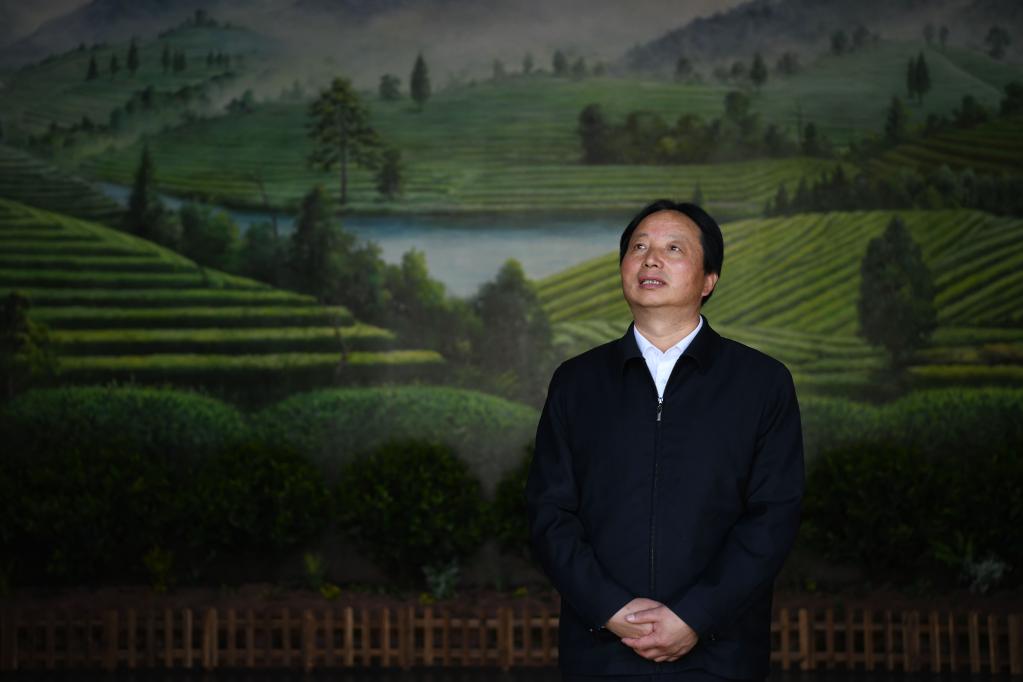
Wang Chang poses for a photo at his tea company in Qimen County, east China's Anhui Province, Nov. 26, 2022. Keemun black tea, one of the most famous Chinese tea with intensive aroma, has a history of more than 100 years. The tea, also called "Qihong" in Chinese, plays an important role in cultural exchanges between the west and the east. In 2008, the making of Keemun black tea was listed as China's national-level intangible cultural heritage, and nowadays the tea has become a symbol for Anhui Province or even China.
The primary processing of Keemun black tea includes four steps, namely natural withering, rolling, fermenting and drying, lasting from before the Qingming festival (April) to June. After that, the refining of the tea is much more complicated, which mainly includes procedures such as screening, winnowing, compressing, re-drying, blending, piling and packing. Of all the refining steps, blending is the key, which decides the shape, scent, and color of the final tea product.
Wang Chang, born in 1966 in the hometown of Keemun black tea Qimen, has devoted his whole life to the making of the "oriental leaf". As the inheritor of the intangible cultural heritage, he started to know the tea as a child when his father worked in a tea factory and his mother as a tea farmer. He used to sit in a wicker basket hung on the shoulder pole carried by his mother while the other side was the tea basket at that time. Gradually, the Keemun black tea became an indispensable part of him.
In 2008, Wang set up a Keemun black tea company in Qimen County, which not only produces and sells the tea, but also conducts researches on the tea and organizes tea culture activities. Since its foundation, the company has cooperated with China Agricultural University and Anhui Academy of Agricultural Sciences on the making of Keemun black tea and on the building of a smart and clean production line. "Tianzhihong", Keemun black tea product of the company, won the gold award during the World Expo in Milan in 2015 and the grand gold medal during the World Black Tea Quality Evaluation Competition in China in 2019.
By far, Wang Chang has accepted over 40 apprentices on the making of Keemun black tea, among whom arise tea masters and new tea talents. He also organizes campus activities on the intangible cultural heritage and builds practicing bases for college students. In recent years, he has made efforts in the brand promotion, standard setting and quality improvement of Keemun black tea, aiming to make the green leaf a "gold leaf" to enrich the local people and promote the traditional Chinese tea culture. (Xinhua/Zhang Duan)
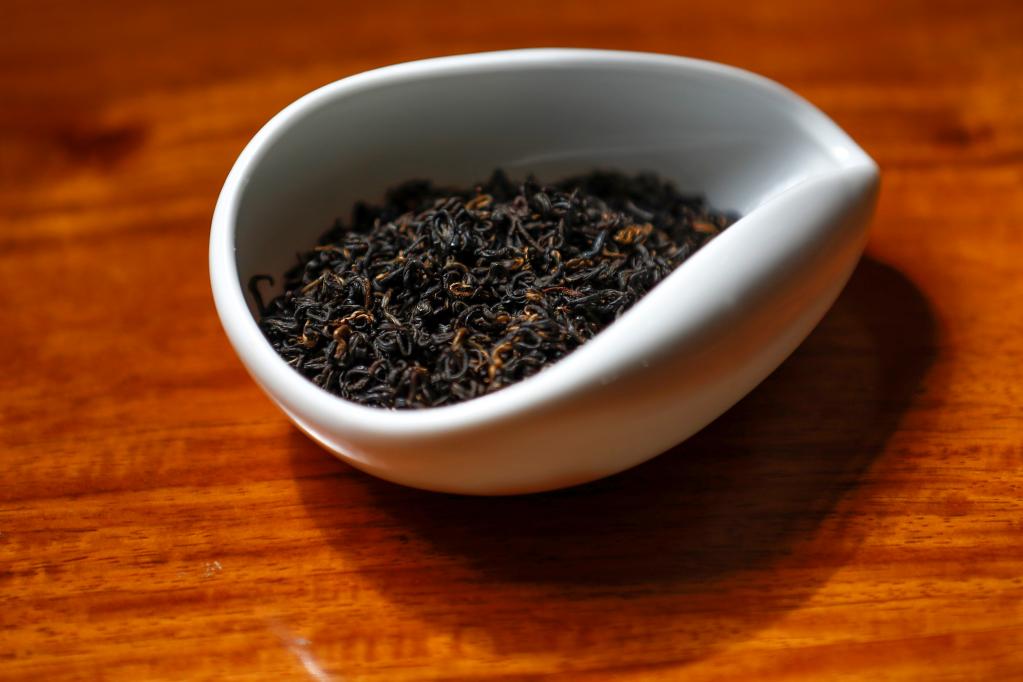
This photo taken on March 28, 2022 shows a Keemun black tea product of Wang Chang's tea company in Qimen County, east China's Anhui Province. Keemun black tea, one of the most famous Chinese tea with intensive aroma, has a history of more than 100 years. The tea, also called "Qihong" in Chinese, plays an important role in cultural exchanges between the west and the east. In 2008, the making of Keemun black tea was listed as China's national-level intangible cultural heritage, and nowadays the tea has become a symbol for Anhui Province or even China.
The primary processing of Keemun black tea includes four steps, namely natural withering, rolling, fermenting and drying, lasting from before the Qingming festival (April) to June. After that, the refining of the tea is much more complicated, which mainly includes procedures such as screening, winnowing, compressing, re-drying, blending, piling and packing. Of all the refining steps, blending is the key, which decides the shape, scent, and color of the final tea product.
Wang Chang, born in 1966 in the hometown of Keemun black tea Qimen, has devoted his whole life to the making of the "oriental leaf". As the inheritor of the intangible cultural heritage, he started to know the tea as a child when his father worked in a tea factory and his mother as a tea farmer. He used to sit in a wicker basket hung on the shoulder pole carried by his mother while the other side was the tea basket at that time. Gradually, the Keemun black tea became an indispensable part of him.
In 2008, Wang set up a Keemun black tea company in Qimen County, which not only produces and sells the tea, but also conducts researches on the tea and organizes tea culture activities. Since its foundation, the company has cooperated with China Agricultural University and Anhui Academy of Agricultural Sciences on the making of Keemun black tea and on the building of a smart and clean production line. "Tianzhihong", Keemun black tea product of the company, won the gold award during the World Expo in Milan in 2015 and the grand gold medal during the World Black Tea Quality Evaluation Competition in China in 2019.
By far, Wang Chang has accepted over 40 apprentices on the making of Keemun black tea, among whom arise tea masters and new tea talents. He also organizes campus activities on the intangible cultural heritage and builds practicing bases for college students. In recent years, he has made efforts in the brand promotion, standard setting and quality improvement of Keemun black tea, aiming to make the green leaf a "gold leaf" to enrich the local people and promote the traditional Chinese tea culture. (Photo by Shi Yalei/Xinhua)

This aerial photo taken on Nov. 26, 2022 shows a tea garden in Qimen County, east China's Anhui Province. Keemun black tea, one of the most famous Chinese tea with intensive aroma, has a history of more than 100 years. The tea, also called "Qihong" in Chinese, plays an important role in cultural exchanges between the west and the east. In 2008, the making of Keemun black tea was listed as China's national-level intangible cultural heritage, and nowadays the tea has become a symbol for Anhui Province or even China.
The primary processing of Keemun black tea includes four steps, namely natural withering, rolling, fermenting and drying, lasting from before the Qingming festival (April) to June. After that, the refining of the tea is much more complicated, which mainly includes procedures such as screening, winnowing, compressing, re-drying, blending, piling and packing. Of all the refining steps, blending is the key, which decides the shape, scent, and color of the final tea product.
Wang Chang, born in 1966 in the hometown of Keemun black tea Qimen, has devoted his whole life to the making of the "oriental leaf". As the inheritor of the intangible cultural heritage, he started to know the tea as a child when his father worked in a tea factory and his mother as a tea farmer. He used to sit in a wicker basket hung on the shoulder pole carried by his mother while the other side was the tea basket at that time. Gradually, the Keemun black tea became an indispensable part of him.
In 2008, Wang set up a Keemun black tea company in Qimen County, which not only produces and sells the tea, but also conducts researches on the tea and organizes tea culture activities. Since its foundation, the company has cooperated with China Agricultural University and Anhui Academy of Agricultural Sciences on the making of Keemun black tea and on the building of a smart and clean production line. "Tianzhihong", Keemun black tea product of the company, won the gold award during the World Expo in Milan in 2015 and the grand gold medal during the World Black Tea Quality Evaluation Competition in China in 2019.
By far, Wang Chang has accepted over 40 apprentices on the making of Keemun black tea, among whom arise tea masters and new tea talents. He also organizes campus activities on the intangible cultural heritage and builds practicing bases for college students. In recent years, he has made efforts in the brand promotion, standard setting and quality improvement of Keemun black tea, aiming to make the green leaf a "gold leaf" to enrich the local people and promote the traditional Chinese tea culture. (Xinhua/Zhang Duan)
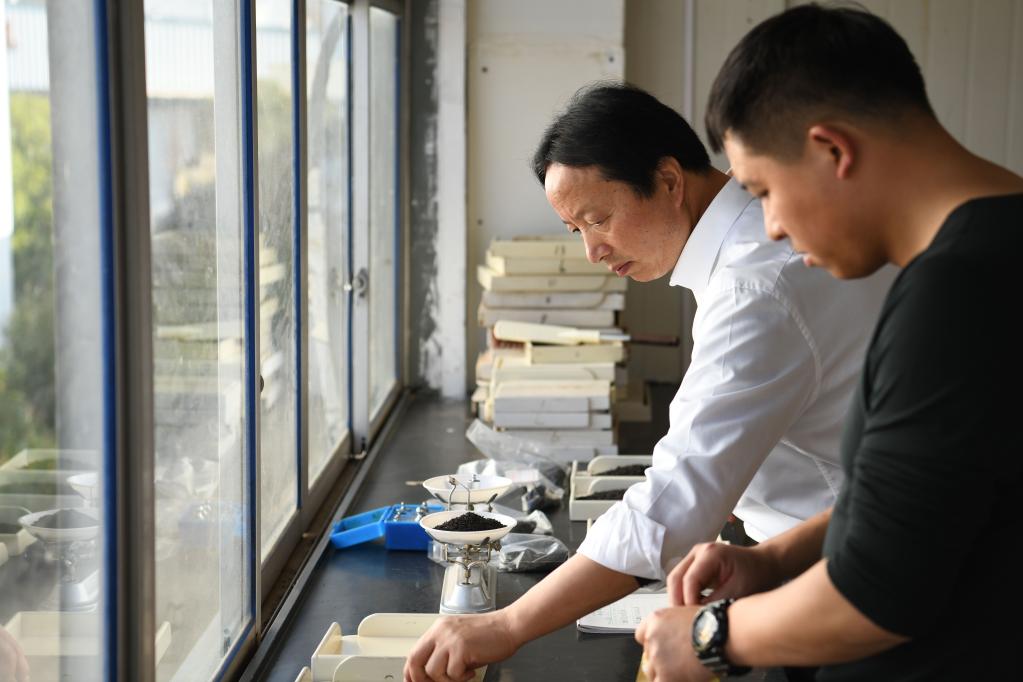
Wang Chang (L) and his apprentice Fan Wenhan do the blending processing of Keemun black tea at his tea company in Qimen County, east China's Anhui Province, Nov. 26, 2022. Keemun black tea, one of the most famous Chinese tea with intensive aroma, has a history of more than 100 years. The tea, also called "Qihong" in Chinese, plays an important role in cultural exchanges between the west and the east. In 2008, the making of Keemun black tea was listed as China's national-level intangible cultural heritage, and nowadays the tea has become a symbol for Anhui Province or even China.
The primary processing of Keemun black tea includes four steps, namely natural withering, rolling, fermenting and drying, lasting from before the Qingming festival (April) to June. After that, the refining of the tea is much more complicated, which mainly includes procedures such as screening, winnowing, compressing, re-drying, blending, piling and packing. Of all the refining steps, blending is the key, which decides the shape, scent, and color of the final tea product.
Wang Chang, born in 1966 in the hometown of Keemun black tea Qimen, has devoted his whole life to the making of the "oriental leaf". As the inheritor of the intangible cultural heritage, he started to know the tea as a child when his father worked in a tea factory and his mother as a tea farmer. He used to sit in a wicker basket hung on the shoulder pole carried by his mother while the other side was the tea basket at that time. Gradually, the Keemun black tea became an indispensable part of him.
In 2008, Wang set up a Keemun black tea company in Qimen County, which not only produces and sells the tea, but also conducts researches on the tea and organizes tea culture activities. Since its foundation, the company has cooperated with China Agricultural University and Anhui Academy of Agricultural Sciences on the making of Keemun black tea and on the building of a smart and clean production line. "Tianzhihong", Keemun black tea product of the company, won the gold award during the World Expo in Milan in 2015 and the grand gold medal during the World Black Tea Quality Evaluation Competition in China in 2019.
By far, Wang Chang has accepted over 40 apprentices on the making of Keemun black tea, among whom arise tea masters and new tea talents. He also organizes campus activities on the intangible cultural heritage and builds practicing bases for college students. In recent years, he has made efforts in the brand promotion, standard setting and quality improvement of Keemun black tea, aiming to make the green leaf a "gold leaf" to enrich the local people and promote the traditional Chinese tea culture. (Xinhua/Zhang Duan)
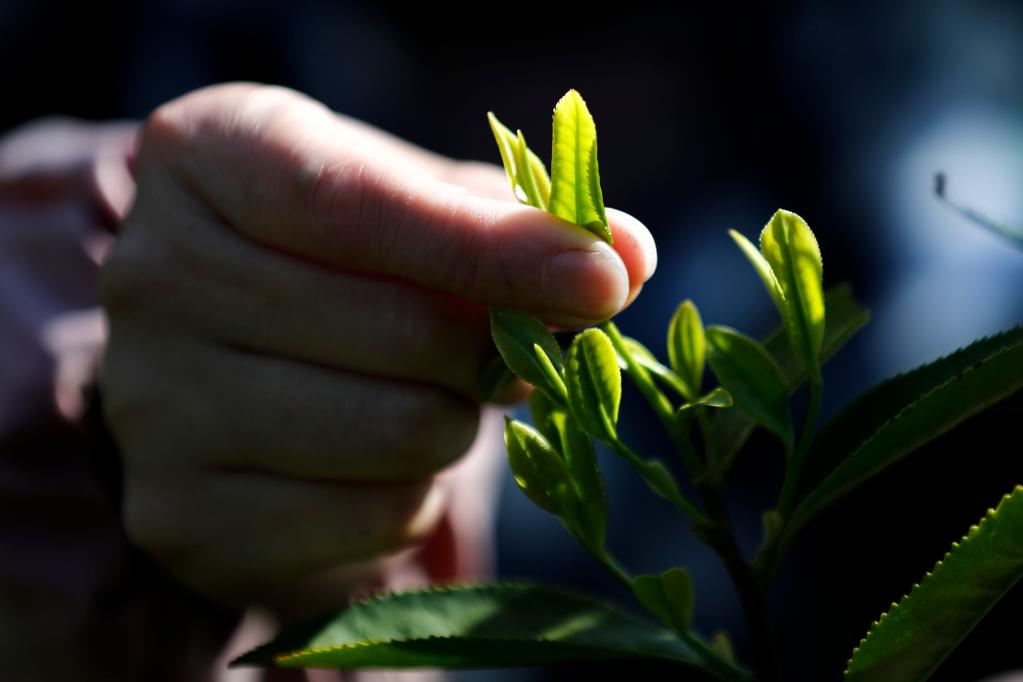
A farmer picks tea leaves at a tea garden in Qimen County, east China's Anhui Province, March 28, 2022. Keemun black tea, one of the most famous Chinese tea with intensive aroma, has a history of more than 100 years. The tea, also called "Qihong" in Chinese, plays an important role in cultural exchanges between the west and the east. In 2008, the making of Keemun black tea was listed as China's national-level intangible cultural heritage, and nowadays the tea has become a symbol for Anhui Province or even China.
The primary processing of Keemun black tea includes four steps, namely natural withering, rolling, fermenting and drying, lasting from before the Qingming festival (April) to June. After that, the refining of the tea is much more complicated, which mainly includes procedures such as screening, winnowing, compressing, re-drying, blending, piling and packing. Of all the refining steps, blending is the key, which decides the shape, scent, and color of the final tea product.
Wang Chang, born in 1966 in the hometown of Keemun black tea Qimen, has devoted his whole life to the making of the "oriental leaf". As the inheritor of the intangible cultural heritage, he started to know the tea as a child when his father worked in a tea factory and his mother as a tea farmer. He used to sit in a wicker basket hung on the shoulder pole carried by his mother while the other side was the tea basket at that time. Gradually, the Keemun black tea became an indispensable part of him.
In 2008, Wang set up a Keemun black tea company in Qimen County, which not only produces and sells the tea, but also conducts researches on the tea and organizes tea culture activities. Since its foundation, the company has cooperated with China Agricultural University and Anhui Academy of Agricultural Sciences on the making of Keemun black tea and on the building of a smart and clean production line. "Tianzhihong", Keemun black tea product of the company, won the gold award during the World Expo in Milan in 2015 and the grand gold medal during the World Black Tea Quality Evaluation Competition in China in 2019.
By far, Wang Chang has accepted over 40 apprentices on the making of Keemun black tea, among whom arise tea masters and new tea talents. He also organizes campus activities on the intangible cultural heritage and builds practicing bases for college students. In recent years, he has made efforts in the brand promotion, standard setting and quality improvement of Keemun black tea, aiming to make the green leaf a "gold leaf" to enrich the local people and promote the traditional Chinese tea culture. (Photo by Shi Yalei/Xinhua)

Wang Chang makes a cup of Keemun black tea in Qimen County, east China's Anhui Province, Nov. 26, 2022. Keemun black tea, one of the most famous Chinese tea with intensive aroma, has a history of more than 100 years. The tea, also called "Qihong" in Chinese, plays an important role in cultural exchanges between the west and the east. In 2008, the making of Keemun black tea was listed as China's national-level intangible cultural heritage, and nowadays the tea has become a symbol for Anhui Province or even China.
The primary processing of Keemun black tea includes four steps, namely natural withering, rolling, fermenting and drying, lasting from before the Qingming festival (April) to June. After that, the refining of the tea is much more complicated, which mainly includes procedures such as screening, winnowing, compressing, re-drying, blending, piling and packing. Of all the refining steps, blending is the key, which decides the shape, scent, and color of the final tea product.
Wang Chang, born in 1966 in the hometown of Keemun black tea Qimen, has devoted his whole life to the making of the "oriental leaf". As the inheritor of the intangible cultural heritage, he started to know the tea as a child when his father worked in a tea factory and his mother as a tea farmer. He used to sit in a wicker basket hung on the shoulder pole carried by his mother while the other side was the tea basket at that time. Gradually, the Keemun black tea became an indispensable part of him.
In 2008, Wang set up a Keemun black tea company in Qimen County, which not only produces and sells the tea, but also conducts researches on the tea and organizes tea culture activities. Since its foundation, the company has cooperated with China Agricultural University and Anhui Academy of Agricultural Sciences on the making of Keemun black tea and on the building of a smart and clean production line. "Tianzhihong", Keemun black tea product of the company, won the gold award during the World Expo in Milan in 2015 and the grand gold medal during the World Black Tea Quality Evaluation Competition in China in 2019.
By far, Wang Chang has accepted over 40 apprentices on the making of Keemun black tea, among whom arise tea masters and new tea talents. He also organizes campus activities on the intangible cultural heritage and builds practicing bases for college students. In recent years, he has made efforts in the brand promotion, standard setting and quality improvement of Keemun black tea, aiming to make the green leaf a "gold leaf" to enrich the local people and promote the traditional Chinese tea culture. (Xinhua/Zhang Duan)
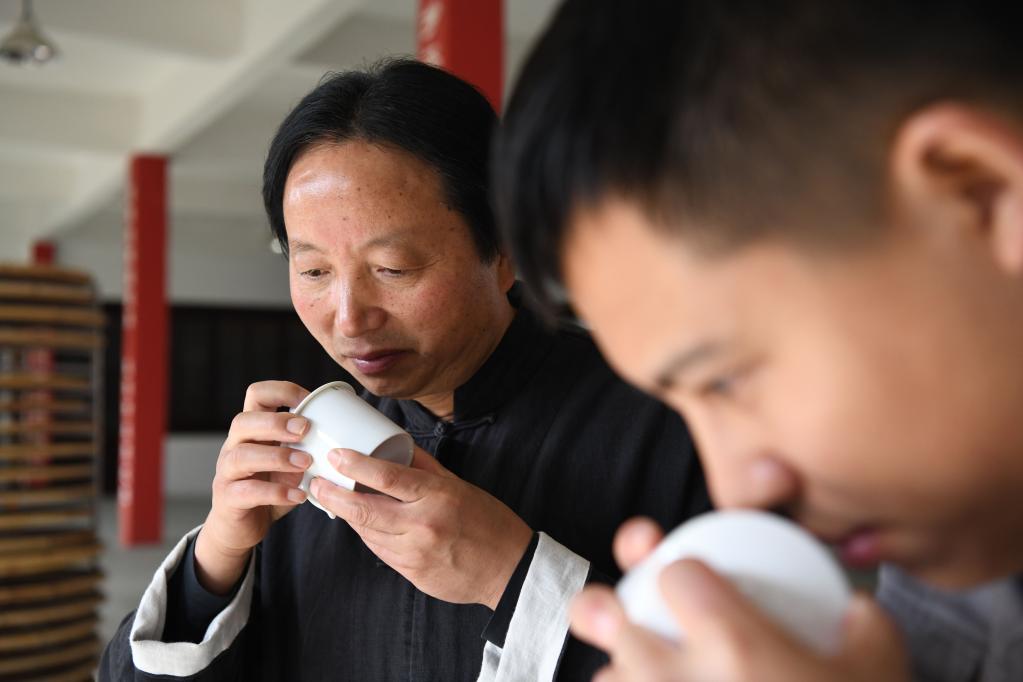
Wang Chang (L) and his apprentice Fan Wenhan evalutate a Keemun black tea product at a tea garden in Qimen County, east China's Anhui Province, Nov. 26, 2022. Keemun black tea, one of the most famous Chinese tea with intensive aroma, has a history of more than 100 years. The tea, also called "Qihong" in Chinese, plays an important role in cultural exchanges between the west and the east. In 2008, the making of Keemun black tea was listed as China's national-level intangible cultural heritage, and nowadays the tea has become a symbol for Anhui Province or even China.
The primary processing of Keemun black tea includes four steps, namely natural withering, rolling, fermenting and drying, lasting from before the Qingming festival (April) to June. After that, the refining of the tea is much more complicated, which mainly includes procedures such as screening, winnowing, compressing, re-drying, blending, piling and packing. Of all the refining steps, blending is the key, which decides the shape, scent, and color of the final tea product.
Wang Chang, born in 1966 in the hometown of Keemun black tea Qimen, has devoted his whole life to the making of the "oriental leaf". As the inheritor of the intangible cultural heritage, he started to know the tea as a child when his father worked in a tea factory and his mother as a tea farmer. He used to sit in a wicker basket hung on the shoulder pole carried by his mother while the other side was the tea basket at that time. Gradually, the Keemun black tea became an indispensable part of him.
In 2008, Wang set up a Keemun black tea company in Qimen County, which not only produces and sells the tea, but also conducts researches on the tea and organizes tea culture activities. Since its foundation, the company has cooperated with China Agricultural University and Anhui Academy of Agricultural Sciences on the making of Keemun black tea and on the building of a smart and clean production line. "Tianzhihong", Keemun black tea product of the company, won the gold award during the World Expo in Milan in 2015 and the grand gold medal during the World Black Tea Quality Evaluation Competition in China in 2019.
By far, Wang Chang has accepted over 40 apprentices on the making of Keemun black tea, among whom arise tea masters and new tea talents. He also organizes campus activities on the intangible cultural heritage and builds practicing bases for college students. In recent years, he has made efforts in the brand promotion, standard setting and quality improvement of Keemun black tea, aiming to make the green leaf a "gold leaf" to enrich the local people and promote the traditional Chinese tea culture. (Xinhua/Zhang Duan)
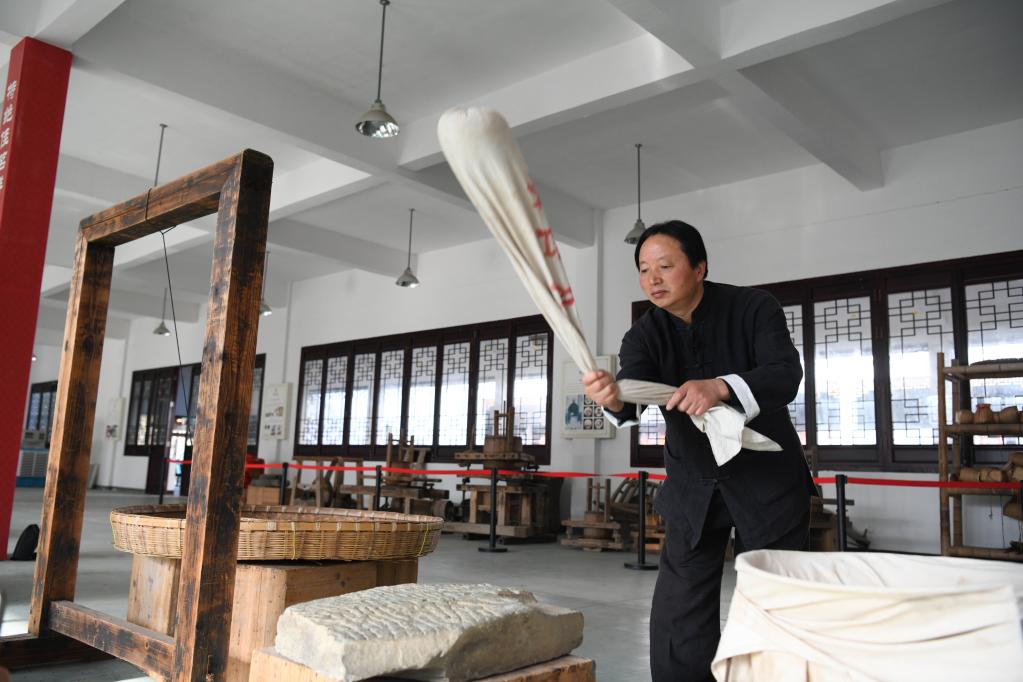
Wang Chang does the bagging and beating processing of Keemun black tea at a tea garden in Qimen County, east China's Anhui Province, Nov. 26, 2022. Keemun black tea, one of the most famous Chinese tea with intensive aroma, has a history of more than 100 years. The tea, also called "Qihong" in Chinese, plays an important role in cultural exchanges between the west and the east. In 2008, the making of Keemun black tea was listed as China's national-level intangible cultural heritage, and nowadays the tea has become a symbol for Anhui Province or even China.
The primary processing of Keemun black tea includes four steps, namely natural withering, rolling, fermenting and drying, lasting from before the Qingming festival (April) to June. After that, the refining of the tea is much more complicated, which mainly includes procedures such as screening, winnowing, compressing, re-drying, blending, piling and packing. Of all the refining steps, blending is the key, which decides the shape, scent, and color of the final tea product.
Wang Chang, born in 1966 in the hometown of Keemun black tea Qimen, has devoted his whole life to the making of the "oriental leaf". As the inheritor of the intangible cultural heritage, he started to know the tea as a child when his father worked in a tea factory and his mother as a tea farmer. He used to sit in a wicker basket hung on the shoulder pole carried by his mother while the other side was the tea basket at that time. Gradually, the Keemun black tea became an indispensable part of him.
In 2008, Wang set up a Keemun black tea company in Qimen County, which not only produces and sells the tea, but also conducts researches on the tea and organizes tea culture activities. Since its foundation, the company has cooperated with China Agricultural University and Anhui Academy of Agricultural Sciences on the making of Keemun black tea and on the building of a smart and clean production line. "Tianzhihong", Keemun black tea product of the company, won the gold award during the World Expo in Milan in 2015 and the grand gold medal during the World Black Tea Quality Evaluation Competition in China in 2019.
By far, Wang Chang has accepted over 40 apprentices on the making of Keemun black tea, among whom arise tea masters and new tea talents. He also organizes campus activities on the intangible cultural heritage and builds practicing bases for college students. In recent years, he has made efforts in the brand promotion, standard setting and quality improvement of Keemun black tea, aiming to make the green leaf a "gold leaf" to enrich the local people and promote the traditional Chinese tea culture. (Xinhua/Zhang Duan)
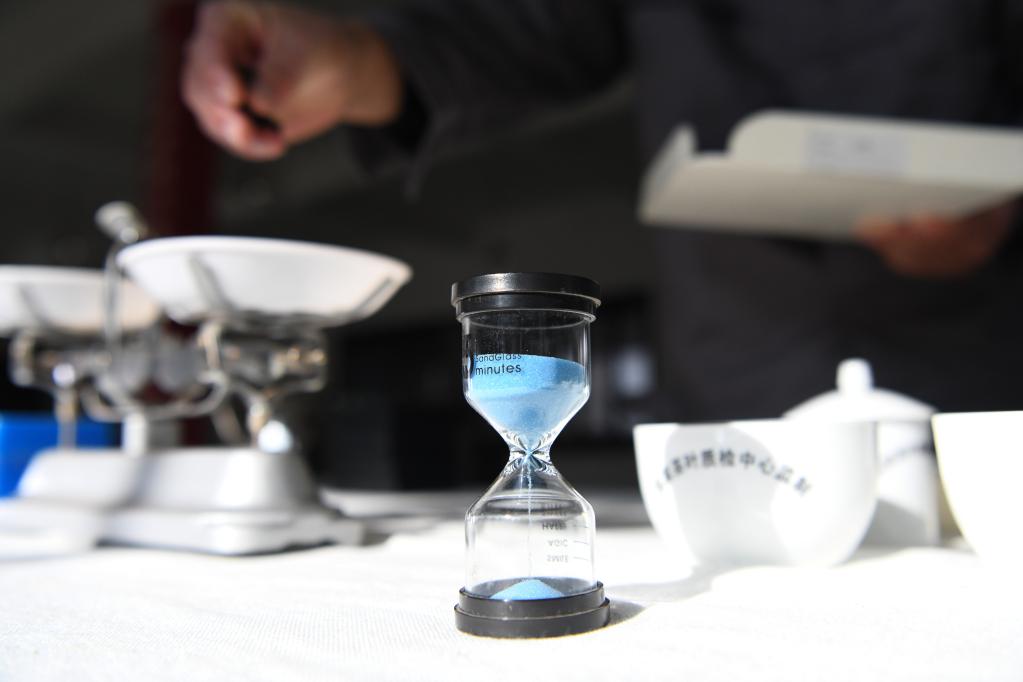
Fan Wenhan, apprentice of Wang Chang, evaluates the processing of Keemun black tea at a tea garden in Qimen County, east China's Anhui Province, Nov. 26, 2022. Keemun black tea, one of the most famous Chinese tea with intensive aroma, has a history of more than 100 years. The tea, also called "Qihong" in Chinese, plays an important role in cultural exchanges between the west and the east. In 2008, the making of Keemun black tea was listed as China's national-level intangible cultural heritage, and nowadays the tea has become a symbol for Anhui Province or even China.
The primary processing of Keemun black tea includes four steps, namely natural withering, rolling, fermenting and drying, lasting from before the Qingming festival (April) to June. After that, the refining of the tea is much more complicated, which mainly includes procedures such as screening, winnowing, compressing, re-drying, blending, piling and packing. Of all the refining steps, blending is the key, which decides the shape, scent, and color of the final tea product.
Wang Chang, born in 1966 in the hometown of Keemun black tea Qimen, has devoted his whole life to the making of the "oriental leaf". As the inheritor of the intangible cultural heritage, he started to know the tea as a child when his father worked in a tea factory and his mother as a tea farmer. He used to sit in a wicker basket hung on the shoulder pole carried by his mother while the other side was the tea basket at that time. Gradually, the Keemun black tea became an indispensable part of him.
In 2008, Wang set up a Keemun black tea company in Qimen County, which not only produces and sells the tea, but also conducts researches on the tea and organizes tea culture activities. Since its foundation, the company has cooperated with China Agricultural University and Anhui Academy of Agricultural Sciences on the making of Keemun black tea and on the building of a smart and clean production line. "Tianzhihong", Keemun black tea product of the company, won the gold award during the World Expo in Milan in 2015 and the grand gold medal during the World Black Tea Quality Evaluation Competition in China in 2019.
By far, Wang Chang has accepted over 40 apprentices on the making of Keemun black tea, among whom arise tea masters and new tea talents. He also organizes campus activities on the intangible cultural heritage and builds practicing bases for college students. In recent years, he has made efforts in the brand promotion, standard setting and quality improvement of Keemun black tea, aiming to make the green leaf a "gold leaf" to enrich the local people and promote the traditional Chinese tea culture. (Xinhua/Zhang Duan)
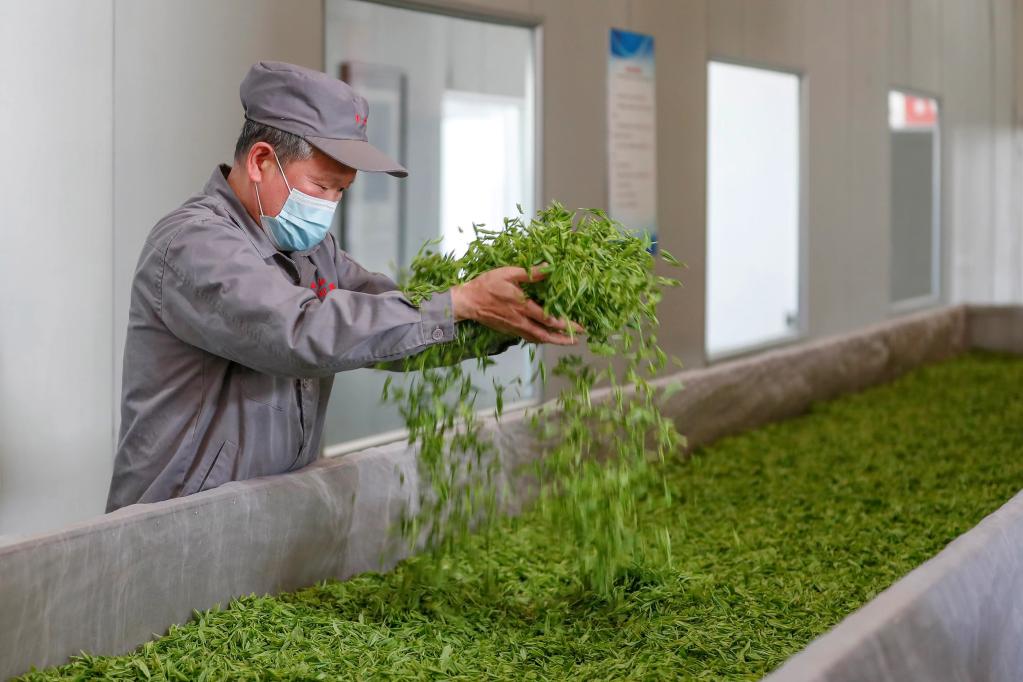
A worker puts fresh tea leaves into a withering machine at Wang Chang's tea company in Qimen County, east China's Anhui Province, March 28, 2022. Keemun black tea, one of the most famous Chinese tea with intensive aroma, has a history of more than 100 years. The tea, also called "Qihong" in Chinese, plays an important role in cultural exchanges between the west and the east. In 2008, the making of Keemun black tea was listed as China's national-level intangible cultural heritage, and nowadays the tea has become a symbol for Anhui Province or even China.
The primary processing of Keemun black tea includes four steps, namely natural withering, rolling, fermenting and drying, lasting from before the Qingming festival (April) to June. After that, the refining of the tea is much more complicated, which mainly includes procedures such as screening, winnowing, compressing, re-drying, blending, piling and packing. Of all the refining steps, blending is the key, which decides the shape, scent, and color of the final tea product.
Wang Chang, born in 1966 in the hometown of Keemun black tea Qimen, has devoted his whole life to the making of the "oriental leaf". As the inheritor of the intangible cultural heritage, he started to know the tea as a child when his father worked in a tea factory and his mother as a tea farmer. He used to sit in a wicker basket hung on the shoulder pole carried by his mother while the other side was the tea basket at that time. Gradually, the Keemun black tea became an indispensable part of him.
In 2008, Wang set up a Keemun black tea company in Qimen County, which not only produces and sells the tea, but also conducts researches on the tea and organizes tea culture activities. Since its foundation, the company has cooperated with China Agricultural University and Anhui Academy of Agricultural Sciences on the making of Keemun black tea and on the building of a smart and clean production line. "Tianzhihong", Keemun black tea product of the company, won the gold award during the World Expo in Milan in 2015 and the grand gold medal during the World Black Tea Quality Evaluation Competition in China in 2019.
By far, Wang Chang has accepted over 40 apprentices on the making of Keemun black tea, among whom arise tea masters and new tea talents. He also organizes campus activities on the intangible cultural heritage and builds practicing bases for college students. In recent years, he has made efforts in the brand promotion, standard setting and quality improvement of Keemun black tea, aiming to make the green leaf a "gold leaf" to enrich the local people and promote the traditional Chinese tea culture. (Photo by Shi Yalei/Xinhua)



